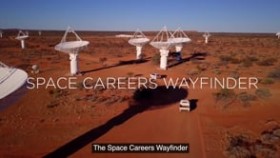Shaking Things Up at the AITC
Over the next few years the AITC will perform the launch certification for a number of Australian satellites. This week, teams from DSTO, UNSW Canberra, EOS and ANU learnt how to specify and conduct a vibration test campaign.
During launch and ascent, a rocket generates extreme vibration and noise. During separation, pyrotechnic shock adds additional stress on the launch vehicle and payload. Before a launch certificate can be issued, customers must demonstrate that their satellite will survive this environment and not cause damage to the launch vehicle or other payloads. Satellite developers are also keen to demonstrate that their satellite will operate as designed and not end up as space junk.
The new facilities at the ANU Advanced Instrumentation and Technology Centre (AITC) in Canberra simulate the environmental conditions of launch and orbit, allowing Australian satellite developers to test their satellite and evaluate their performance.
This week experts from Bruel & Kjaer and Cal Poly joined the AITC team to conduct an intensive vibration test training course. The course included basic theory and plenty of hands-on experience. It also introduced the teams to the realities of conducting a test campaign with a few unexpected late nights.
DSTO is preparing for the integration and test of their Buccaneer satellite. “I thought I understood how our spacecraft would respond to vibration but after this week I realise that there are a lot of subtleties to vibration testing and evaluation. I also didn’t appreciate how long it took, how many people it takes, and how detailed it is. We are definitely now better prepared to plan our tests” Iain Cartwright, Space Systems Engineer, DSTO.
Iain also commented that “It’s been good to get this practical experience early enough that we can feed it back into the satellite development and increase our confidence in the success of the mission. If we waited for the final test campaign it would be too late.”
Maurizio Demontis from Bruel & Kjaer was on hand to deliver the theoretical component and share his detailed knowledge of the equipment. Bruel & Kjaer is a world-leader in vibration measurement and analysis and their vibration test facilities can be found in major aerospace companies around the world. The AITC is very proud to have two LND electrodynamic shakers, 22 kN and 400 N, with Bruel & Kjaer control equipment and software, and to be partnering with Bruel & Kjaer to provide training.
“This training course has been important for getting the practical experience we need to support our own satellite development at UNSW Canberra. It also provides another opportunity to strengthen the relationship between UNSW and ANU” Dr Philippe Lorrain, Test and Evaluation Engineer, UNSW Canberra.
Collaboration is growing amongst the Australian and international community. In April Cal Poly and ANU signed an MOU to support increased collaboration in space systems. “Cal Poly played a key role in the development of the CubeSat standard and they have more experience in CubeSats than anyone in the world. If the AITC is going to effectively support the Australian space community, it makes sense for us to partner with the best in the world.” Dr Naomi Mathers, Industry Liaison Engineer, ANU AITC
The participants were treated to the experience and knowledge of two key personnel from the Cal Poly CubeSat Team. Ryan Nugent and Justin Foley have worked on more than 135 satellites, giving them extraordinary knowledge of the CubeSat platform, CubeSat Test Pod and P-Pod Deployer. “The CubeSat platform provides an affordable platform for universities to get involved in space activities but it’s important for the whole community to increase the chance of mission success through good systems engineering and test and evaluation.” Ryan Nugent, Aerospace Engineer, Cal Poly CubeSat Program.
“This week has been a good opportunity to get to know CubeSat developers in Australia and strengthen our relationship with Australia,” said Ryan. This included the opportunity to use the ANU Satellite Ground Station to download data from the Planetary Society Light Sail mission. Cal Poly is the primary communications provider for Light Sail. “Having access to a ground station in the southern hemisphere increases the amount of data that can be collected, which is really important with such a short mission,” said Justin Foley, Systems Engineer, Cal Poly CubeSat Program. Many participants joined Justin in the late evening to monitor the pass and see how the data was downloaded.
The AITC would like to thank the experts and the participants for a great week and we look forward to seeing them all again during their test campaigns.















